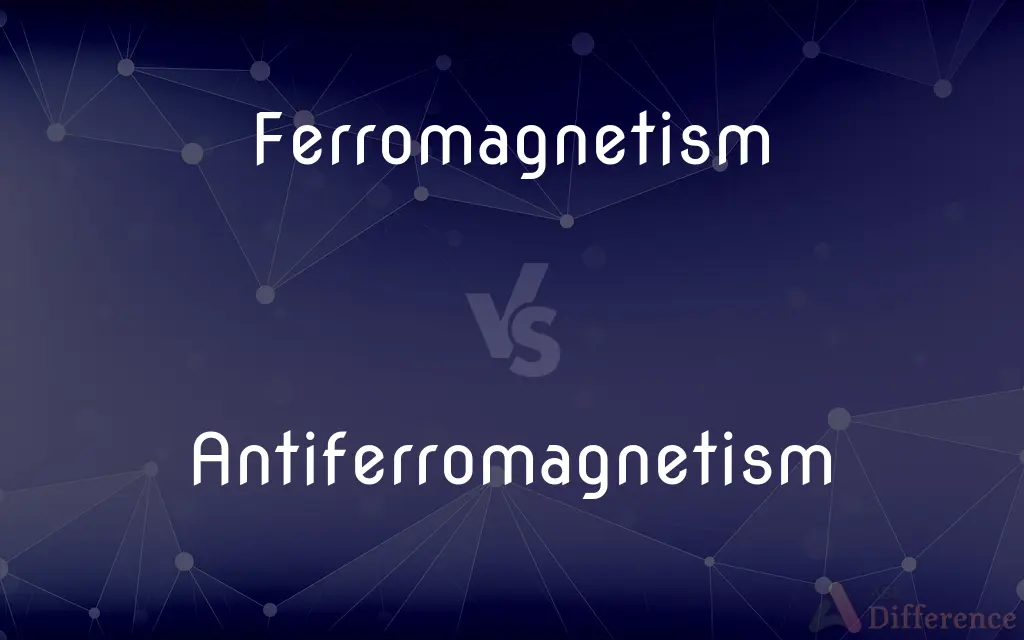Ferromagnetism vs. Antiferromagnetism — What's the Difference?
Edited by Tayyaba Rehman — By Urooj Arif — Updated on March 16, 2024
Ferromagnetism involves alignment of magnetic moments in the same direction, whereas antiferromagnetism involves opposite alignment, canceling out magnetism.

Difference Between Ferromagnetism and Antiferromagnetism
Table of Contents
ADVERTISEMENT
Key Differences
Ferromagnetism is characterized by the alignment of magnetic moments in parallel, leading to strong magnetic properties. On the other hand, antiferromagnetism involves the alignment of magnetic moments in an alternating pattern, resulting in the cancellation of magnetic fields within the material.
Ferromagnetism allows materials to exhibit strong magnetic fields, which is utilized in a variety of applications that require permanent magnets or magnetic storage devices. This property is due to the collective alignment of magnetic moments that reinforce each other. Whereas antiferromagnetism leads to materials having negligible or no external magnetic fields, making them suitable for applications requiring magnetic order without external magnetism.
The temperature dependence of ferromagnetism is such that above a certain temperature, known as the Curie temperature, ferromagnetic materials lose their magnetic properties and become paramagnetic. This is because thermal energy disrupts the alignment of magnetic moments. Conversely, antiferromagnetic materials have a similar transition at the Néel temperature, above which they become paramagnetic.
Comparison Chart
Magnetic Alignment
Parallel alignment of magnetic moments
Antiparallel alignment of magnetic moments
Magnetic Field
Strong external magnetic fields
Negligible or no external magnetic field
ADVERTISEMENT
Material Examples
Iron, Cobalt, Nickel
Manganese oxide, Iron oxide
Applications
Magnetic storage, Motors, Generators
Spintronic devices, MRI technology
Temperature Dependence
Loses magnetism above Curie temperature
Becomes paramagnetic above Néel temperature
Compare with Definitions
Ferromagnetism
Characterized by materials that can become permanent magnets.
Nickel's ferromagnetic properties make it ideal for coinage.
Antiferromagnetism
A magnetic phenomenon where adjacent ions’ magnetic moments point in opposite directions.
Manganese oxide demonstrates antiferromagnetism at low temperatures.
Ferromagnetism
Involves the retention of magnetic properties even without an external magnetic field.
Cobalt retains its magnetism, showcasing ferromagnetism.
Antiferromagnetism
Useful in applications requiring controlled magnetic properties without external magnetism.
Antiferromagnetic materials are crucial in advanced computing devices.
Ferromagnetism
A phenomenon where magnetic moments align parallel to each other, creating strong magnetic fields.
Iron becomes a powerful magnet due to ferromagnetism.
Antiferromagnetism
Important in the study of complex magnetic ordering and spintronics.
Research in antiferromagnetism paves the way for new magnetic storage technologies.
Ferromagnetism
Dependent on the material’s response to the external magnetic field.
Ferromagnetism in iron is utilized in magnetic storage devices.
Antiferromagnetism
Results in materials having little to no external magnetic field.
Antiferromagnetism in iron oxide makes it invisible to a magnetic field.
Ferromagnetism
Exhibits a transition to paramagnetism above the Curie temperature.
Heating a ferromagnetic material above its Curie temperature reduces its magnetism.
Antiferromagnetism
Shows a transition to paramagnetism above the Néel temperature.
Antiferromagnetic materials become paramagnetic when heated above the Néel temperature.
Ferromagnetism
Ferromagnetism is the basic mechanism by which certain materials (such as iron) form permanent magnets, or are attracted to magnets. In physics, several different types of magnetism are distinguished.
Antiferromagnetism
In materials that exhibit antiferromagnetism, the magnetic moments of atoms or molecules, usually related to the spins of electrons, align in a regular pattern with neighboring spins (on different sublattices) pointing in opposite directions. This is, like ferromagnetism and ferrimagnetism, a manifestation of ordered magnetism.
Ferromagnetism
Of or characteristic of substances such as iron, nickel, or cobalt and various alloys that exhibit extremely high magnetic permeability, a characteristic saturation point, and magnetic hysteresis.
Antiferromagnetism
(physics) a phenomenon, similar to ferromagnetism, in which magnetic domains line up in a regular pattern, but with neighbouring electron spins pointing in opposite directions; materials showing this effect are either ferrimagnetic or diamagnetic, and become paramagnetic above the Neel temperature
Ferromagnetism
(physics) The phenomenon whereby certain substances can become permanent magnets when subjected to a magnetic field.
Antiferromagnetism
Magnetic field creates parallel but opposing spins; varies with temperature
Ferromagnetism
Phenomenon exhibited by materials like iron (nickel or cobalt) that become magnetized in a magnetic field and retain their magnetism when the field is removed
Common Curiosities
Can antiferromagnetic materials be used as magnets?
No, antiferromagnetic materials cannot be used as conventional magnets since their internal magnetic moments cancel each other out.
What are the applications of ferromagnetism?
Ferromagnetism is used in magnetic storage, electric motors, generators, and permanent magnets.
What is the Néel temperature?
The Néel temperature is the temperature above which antiferromagnetic materials become paramagnetic.
What are the applications of antiferromagnetism?
Antiferromagnetism has applications in spintronics and magnetic resonance imaging (MRI) technology.
What is the difference in magnetic field generation between ferromagnetic and antiferromagnetic materials?
Ferromagnetic materials generate strong external magnetic fields due to parallel alignment of magnetic moments, while antiferromagnetic materials do not generate external magnetic fields due to the antiparallel alignment.
What is antiferromagnetism?
Antiferromagnetism is the alignment of magnetic moments in opposite directions, resulting in the cancellation of external magnetic fields.
Do all metals exhibit ferromagnetism?
No, only certain metals like iron, cobalt, and nickel exhibit ferromagnetism.
Are all materials with magnetic properties ferromagnetic?
No, materials can exhibit different types of magnetic properties, such as ferromagnetism, antiferromagnetism, or paramagnetism.
How do ferromagnetic materials behave above the Curie temperature?
Above the Curie temperature, ferromagnetic materials lose their magnetic properties and become paramagnetic.
What is the role of spin in ferromagnetism and antiferromagnetism?
Spin plays a crucial role in both phenomena, determining the alignment of magnetic moments within the materials.
Why are antiferromagnetic materials important in technology?
Antiferromagnetic materials are important for their unique magnetic properties, which are useful in developing spintronic devices and enhancing MRI technology.
How do ferromagnetic and antiferromagnetic materials differ in structure?
Ferromagnetic materials have a uniform magnetic moment alignment, while antiferromagnetic materials have a staggered alignment that cancels out overall magnetism.
Can the magnetic properties of ferromagnetic materials be reversed?
Yes, by applying a strong enough opposite magnetic field, the magnetic properties of ferromagnetic materials can be reversed.
How does temperature affect antiferromagnetic materials?
Antiferromagnetic materials become paramagnetic when heated above the Néel temperature, losing their antiferromagnetic ordering.
Share Your Discovery

Previous Comparison
Lineman vs. Linesman
Next Comparison
Adolescent vs. TeenagerAuthor Spotlight
Written by
Urooj ArifUrooj is a skilled content writer at Ask Difference, known for her exceptional ability to simplify complex topics into engaging and informative content. With a passion for research and a flair for clear, concise writing, she consistently delivers articles that resonate with our diverse audience.
Edited by
Tayyaba RehmanTayyaba Rehman is a distinguished writer, currently serving as a primary contributor to askdifference.com. As a researcher in semantics and etymology, Tayyaba's passion for the complexity of languages and their distinctions has found a perfect home on the platform. Tayyaba delves into the intricacies of language, distinguishing between commonly confused words and phrases, thereby providing clarity for readers worldwide.
















































